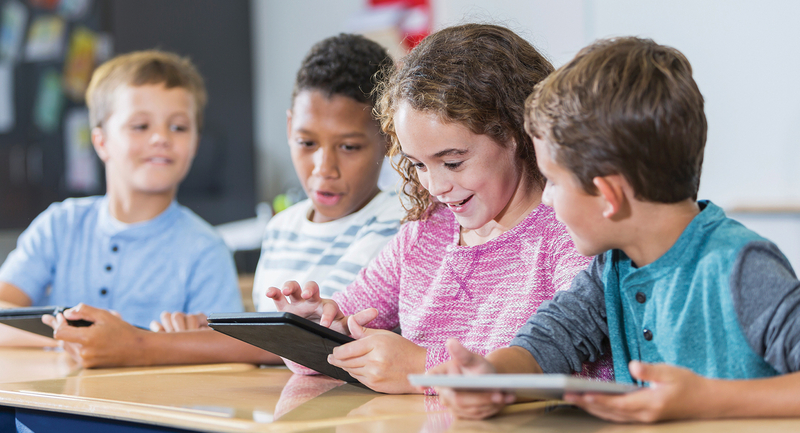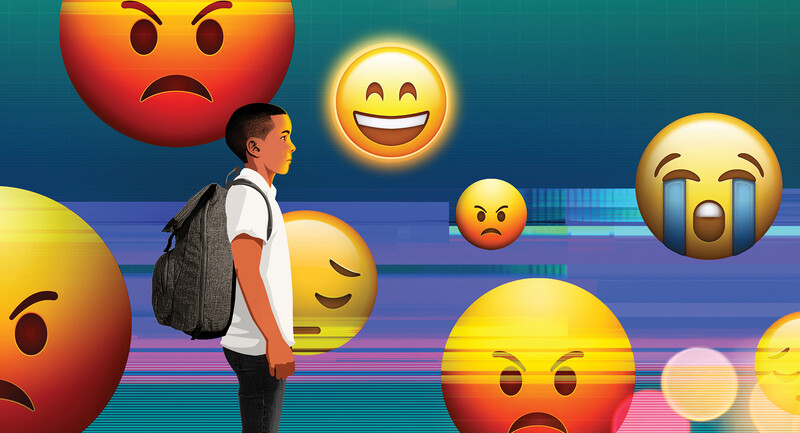For decades, technology enthusiasts have proclaimed digital tools would change schooling as we know it. Hopeful statements promising equitable access to unlimited information or soaring test scores have accompanied the purchase of computers and other devices. While technology in and of itself cannot transform learning, the important question becomes: Are educators applying digital tools to create student-centered, hands-on, inquiry-based learning environments, or have we hijacked the potential of technology in service of "business-as-usual" teaching?
At the Center for Technology and School Change at Teachers College, Columbia University, we have worked with hundreds of schools over the last two decades, gaining valuable insights through research and practice. We have identified a gap between the expectation that teachers will use technology effectively to shift their teaching practices and the actual guidance they receive in learning how to do so. Policymakers and school leaders tell educators to use technology, but often there is little support for learning to use technology in ways that support pedagogical practices that truly transform the learning environment and sustain change. Technology as a Catalyst for Pedagogical Change
The potential for technology to deepen learning is enormous and exciting, but these shifts require time and investment in our teachers and administrators. As Mehta and Fine (2019) explain, "creating deeper learning is not only about improving pedagogy but also about building demand for a different approach to learning."
Our Center's research team has refined an approach to introduce technology as a catalyst for critical pedagogical changes, changes that can lead to deeper student knowledge. The digital applications that many technology specialists share with teachers often simply introduce digitized versions of didactic teaching. Instead, our professional development team starts with a discussion of teaching and learning goals rather than using technology as the driver. This flips the usual order of things: instead of adding technology on top of existing lessons and instructional practices, we support teachers in identifying a critical issue or question for students to explore—a culturally relevant problem that is related to the curriculum and the standards they are addressing.
Digital tools can be instrumental in helping students frame project questions, collaborate on ideas and solutions, and explore resources in ways that deepen their understanding and build important skills.
We then work alongside teachers to co-design an engaging project around this query, using technology tools to do what technology can do best: open up new opportunities for equitable student learning. From the purview of inquiry-based learning, digital tools can be instrumental in helping students frame project questions, collaborate on ideas and solutions, and explore resources in ways that deepen their understanding and build important skills. Even emerging technologies such as chatbots can be seen as thinking aids that support students' growing knowledge-building sophistication. Our work is sensitive to the unique needs of each school, and we work with leaders, before, during, and after implementation of the project to support the transitions teachers are making with their students.
For instance, in one of our New York City initiatives, funded by the National Science Foundation, our Center's professional development team worked with a group of 5th grade teachers to develop a transdisciplinary project focused on "survival." Together, the teachers and Center facilitators developed the question, "How can we, as humans, contribute to the quality of life of a species?" The project required students to compare habitats in a neighboring zoo to those of species living in the wild. The students constructed an argument supported by empirical evidence about the biological components of an ecosystem and the effect on a species' population. They dug deeply into research and offered solutions for new habitat designs for their local zoo, prototyping these designs with both recycled and repurposed materials and 3D CAD programs and digital modeling.
In another Borough in New York City, we co-developed and implemented an interdisciplinary project focused on the concept of "change" with 8th grade teachers. As schools shut down in the early days of the pandemic and learning went virtual, these students continued to work in online groups using apps that supported social and collaborative learning as they worked to investigate changes in their community in the face of long-standing systemic challenges around justice, equity, and racism. Using knowledge and skills in mathematics, social studies, science, and ELA, the students adopted the roles of data scientists and policymakers to interpret historical patterns of impact in areas of wealth, employment, and policing and then forecast future outcomes. The students then shared their ideas with their peers and advocated for change using a variety of multimedia strategies and platforms.
Projects like these exemplify the goal of our Center's work—to support teachers in making pedagogical shifts toward inquiry learning, using the affordances of technology to inspire new learning opportunities that can equitably engage all students. This has required that we develop a research-based approach to technology integration centered on a growing understanding of the 'developing brain' and how students learn (National Academies of Sciences, Engineering, and Medicine, 2018). We adopt the perspective that deep learning can occur when students tug at ideas, wrestle with concepts, and ask challenging questions of their peers, subject-matter experts, and themselves. In this light, we encourage the use of technology to support students as problem solvers, creators, and investigators who explore, acquire, organize, and share information to develop disciplinary understandings and transdisciplinary thinking.
What We Have Learned
While many educators are familiar with the ideas behind deeper learning, most have not had the preparation to act on these ideas in ways that will transform the culture of their classroom. Similarly, teachers may understand the promise of technology, but need specific support to design classroom learning environments that incorporate digital tools in service of pedagogical shifts that can deepen learning for all students.
Because of this, the Center's strategy has been to work toward a school change approach that begins by introducing teachers and school leaders to a design process for developing transdisciplinary student-centered projects. The design process uses technology to support student inquiry and investigation. Our research in underserved urban schools over the last several years with many hundreds of teachers and the support of three National Science Foundation grants has given us a substantive understanding of what may be possible and what continues to stand in the way of more widespread shifts in teaching and learning with technology (Meier & Kirsch Page, 2022; Meier & Mineo, 2021).
Some key understandings have emerged from our work: (1) teachers need in-depth professional learning opportunities, situated to the reality of their school; (2) teachers need the opportunity to design inquiry-based projects that integrate technology meaningfully; (3) teachers need access to digital tools that capture student thinking; and (4) administrators have an important role to play in supporting pedagogical innovation and the integration of technology. These four understandings are central to our research-based professional development model, and our ongoing work in schools.
Technology can play a critical role technology in moving away from transmission teaching toward inquiry-based learning.
1. Provide Teachers with Extended Professional Learning Opportunities Situated in the Reality of Their School and Community
First and foremost, teachers need a coherent professional learning plan that is tailored to their school and community. "One size fits all" or "drive by" professional development—especially offerings that focus exclusively on the tools themselves—do not provide adequate breadth or depth for teachers to make the significant pedagogical shifts that deeper learning opportunities require.
We begin our work in schools with meetings to understand the needs and the context of the school. We have found that providing a range of learning opportunities is important. A typical professional development plan can include: Institutes and workshops, planning meetings, asynchronous online work, classroom visits and critical reflection and feedback sessions. The engagement needs to be long enough and substantive enough for teachers to learn how to design meaningful, standards-aligned opportunities for students.
To help teachers understand the power of project-based learning, our professional development sessions model inquiry and project-based approaches. The facilitators have teaching backgrounds and work closely with educators to design and help implement projects in classrooms. Critical reflection and feedback provide an important final step in an ongoing iteration of the design process.
2. Provide Teachers with Opportunities to Design Inquiry-Based Projects that Integrate Technology Meaningfully
The design process allows teachers to identify authentic and sustaining ways of introducing key concepts, a creatively exciting process (Gutiérrez, 2023). Aligning the work with academic standards, technology standards such as those from the International Society for Technology and Education (ISTE), and social justice standards like those from Learning for Justice can inspire project designs for deep learning. Co-designing lessons and units around essential questions in ways that build student understanding takes teachers more deeply into the knowledge-building process (Wiggins and McTighe, 2005). Inquiry activities support broader student engagement and involve students more actively in the learning process. The integration of technology then becomes a natural next step in the process: teachers learn to make thoughtful decisions about the tools they provide students to enable the creativity and collaboration that accompanies meaningful, inquiry-based learning experiences.
3. Promote the Use of Digital Tools in Ways that Can Deepen Student Thinking
To deepen learning, educators must understand student thinking. Technology can be used to replicate traditional classroom assessment approaches such as multiple-choice tests and digital worksheets, but it can also provide opportunities to understand students' learning processes in new ways. Formative assessment can go beyond the traditional (and often superficial) "exit ticket" exercise. Technology can capture students' reflections about their learning using video, audio, animation, or other multimodal and creative methods. When used in the context of a thoughtful design process, brainstorming tools, organization tools, research tools, and creative production tools can all reveal student progress and provide mechanisms for reflection, sharing students' creative voices, and problem-solving.
Leveraging digital tools to create student-centered learning experiences requires that teachers see themselves as designers, not simply implementers of prescribed curriculum.
4. Encourage Administrators to Support Innovative Instructional Approaches Along with the Use of Technology
Education leaders also need ongoing opportunities to learn about the pedagogical shifts needed for deep learning and the role of technology in supporting those shifts. To lead for innovation, administrators can work with teachers to establish clear goals for technology integration that are aligned with curriculum, standards, and learning objectives. This will help ensure that technology is used in purposeful ways that support student learning, even as students experience the excitement of creative discoveries, analytic tools, and the presentation of their learning to the school community or beyond.
To foster a culture of innovation, administrators must exercise their instructional leadership by encouraging teachers to use student-centered pedagogies. Principals can help teachers make use of open prep periods and common planning time to work with colleagues to design projects. They can also encourage them to take risks with technology and inquiry learning. Districts can invest in leaders by supporting their understanding of pedagogy and technology integration, helping them to understand how it contributes to a larger vision of school improvement. In this way, leaders can develop strategic plans with teachers, providing them with the time and space to innovate in their classrooms. Leaders should also feel encouraged to participate in professional learning alongside teachers as an important way of developing shared meaning around innovation.
Moving Beyond the Status Quo
Schools' approach to innovation and change must go beyond simply putting tools in the hands of teachers. Starting with a discussion of teaching and learning, and introducing digital tools in service of inquiry learning, creates a powerful connection between pedagogy and tools that opens new ways of thinking about the teaching process. Substantive professional learning can provide teachers with the design skills to make this shift and it is necessary to move beyond status quo teaching. Leveraging digital tools to create effective student-centered learning experiences requires that teachers see themselves as designers, not simply implementers of prescribed curriculum. Learning to develop rigorous projects that are culturally relevant and aligned with appropriate standards provides students with opportunities for more meaningful learning.
Technology by itself cannot bring about deeper learning. The broken promises of technology cannot be fixed with newer faster tools; not even ChatGPT can bring about the changes needed. As we continue to learn more about learning, teachers and leaders can continue to develop their design skills to engage all students in deeper knowledge-building opportunities. In an increasingly complex technological landscape, digital tools can then be used, as tools, in service of innovative, student-centered learning environments. Educators committed to creating innovative learning environments have new opportunities to understand the critical role technology can play in moving away from transmission teaching toward inquiry-based learning.








